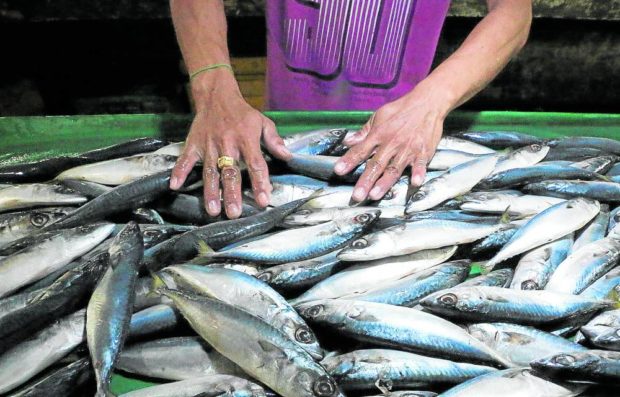PH to import 60,000 tons of fish to cover shortage

MARKET WATCH The Department of Agriculture expects the supply of certain types of fish to run short in the first quarter. It cited, among other reasons, the recent damage caused by Typhoon “Odette” (Rai) on the fisheries sector. —GRIG C. MONTEGRANDE
MANILA, Philippines — The government will import 60,000 metric tons of small pelagic fishes such as round scad (“galunggong”) and mackerel to cover part of an expected shortage in local supply in the first quarter of 2022, Agriculture Secretary William Dar said at the Laging Handa public briefing on Tuesday.
Pelagic fish, according to the US National Oceanic and Atmospheric Administration, got their name from the area that they inhabit called the pelagic zone. It is the largest marine habitat on earth accounting for about a fourth of the total world fisheries catch annually.
Typhoon’s impact
Dar said that he had signed last Monday the required Certificate of Necessity to Import (CNI) because local supply has yet to normalize from the devastation caused by Typhoon Odette (international name: Rai) on many fishing areas late last year.
The Department of Agriculture (DA) said in its latest bulletin that the typhoon’s impact on the farm sector already exceeded P13 billion. The fisheries sub-sector suffered the most with P3.97 billion in losses.
“They are the number one sub-sector of agriculture badly hit during Typhoon Odette. The capacity of our fishers to catch will be in question. You have to enhance their capacities,” he added.
Article continues after this advertisementThe Bureau of Fisheries and Aquatic Resources (BFAR) has projected a fish supply shortfall of 119,000 MT in the first quarter, prompting the move to import to keep supply and selling prices in wet markets stable.
Article continues after this advertisement“At the end of the day, we take responsibility in terms of ensuring food security,” Dar said.
The DA also tasked its attached agencies, BFAR and the Philippine Fisheries Development Authority (PFDA), to deliver imported galunggong or round scads from cold storages to address the current deficit in fish supply.
“I have directed (them) to see to it that these imported galunggong (round scad) reach the wet markets because that’s the very reason why we are bringing additional supply augmentation,” he said.
“So, (BFAR) has the power to open up these cold warehouses and see to it that these are brought to the wet markets,” he added.
Dar said the DA was also enhancing the production of the aquaculture sector to close gaps in fish production and sustainably improve fish catch.
He stressed that this was “a balancing act being done by the department to ensure food security in the whole country.”
Annual fishing ban
The government, through PFDA and BFAR, has yet to set a date for the opening of applications covering the new import volume for qualified importers under the DA’s Fisheries Administrative Order (FAO) 259, which was issued in 2018 to set the rules and regulations on the importation of frozen fish and aquatic products for wet markets during closed and off-fishing seasons or calamities.
Importations have been made necessary by the annual ban on fishing in traditional grounds of local fishermen to allow fish species to spawn and recover.
Three major seas are subjected to a three-month closed fishing season yearly by BFAR. These are the Northeast Palawan Sea (November to January), Visayan Sea (November to January) and the Zamboanga Peninsula that spans across the East Sulu Sea, Basilan Strait and Sibuguey Bay (December to March). It is during this period that fish prices in wet markets usually shoot up.
Permit extension
Last month, the DA already gave its go-ahead to extend until end-January 2022 the validity of permits to import round scad, mackerel and bonito (medium-sized fish in the same family as the mackerel and tuna).
The CNI issued by the DA in August 2021 allowed a maximum importable volume of 60,000 MT. However, the National Economic and Development Authority (Neda) said that as of Dec. 27 last year, only 25,000 MT of imported fish, or 43.8 percent of the allowed volume, arrived in the country through the Navotas fish port.
As such, Neda said end-2021 fish supply likely fell below demand with a deficit of 126,900 MT or 14 days’ worth of stocks, citing BFAR data as of November.
The import permit extension was also meant to address the supply shortfall in Typhoon Odette-hit areas by distributing imported fish in wet markets in affected parts of Visayas and Mindanao and help bring down rising fish prices there.
Data from the Philippine Statistics Authority showed that agricultural output contracted by 2.6 percent in the third quarter of 2021. It already shrank by 3.3 percent in the first quarter and another 1.5 percent in the second quarter.
Initially, the DA was expecting agriculture to grow by 2.5 percent last year. This was lowered to 2 percent and the agency finally gave up on its growth target for 2021 after the sector was hit by natural calamities.